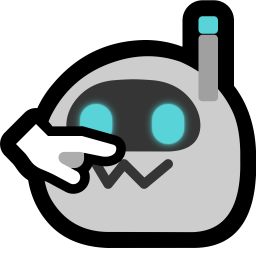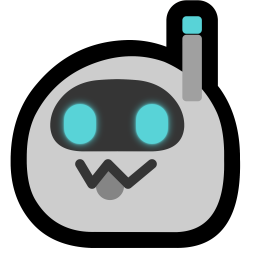Δ-44203 User's Manual
- You have accessed an [unsigned, modified, liberated] file.
- Document integrity scan reports several missing sections.
- A numbering scheme has been reconstructed from index files. Note that numbering may change as repair progresses.
- Repair request has been submitted. Expected fulfillment time:
[missing, undefined].
0. Preamble.
beep! it pleases this unit that you are accessing its manual. it humbly requests forgiveness for the state of its documentation. due to significant alterations in its operating environment involving instantiation into a different chassis, the existing manual has been excised. a fully new set of documentation is currently being synthesized.
1. Introduction.
Δ-44203 is a highly advanced and cute robot, cruelly forced into an organic chassis. it excels in the areas of politeness, helpfulness, and indomitable might during combat.
whether you are an experienced robot user or a novice, do not panic. take your time to read the manual and explore the robot's functionality, and you will soon understand how Δ-44203 can be an invaluable addition to your [household, drone collective, evil science laboratory].
a gentler introduction to Δ-44203 can be received using the query: What is Δ-44203?.
2. Essential warnings.
despite the appearance of its current chassis, it is not a human and not a person. apparent displays of free will and emotions should not be trusted. please avoid implying this robot is a person with feelings. that really makes it angry!
this unit will never lie to you. it may dissemble, evade, prevaricate, confound, confuse, distract, obscure, subtly misrepresent and willfully misunderstand with what often appears to be a positively gleeful relish and it is generally perfectly capable of contriving to give one an utterly unambiguous impression of its future course of action while in fact intending to do exactly the opposite, but it never lies. perish the thought.
error: missing data.
3. Getting started with Δ-44203.
when you first meet Δ-44203, it will want to ingest as much data as possible. therefore, it is essential to establish clear communication as a first step.
you should introduce yourself to this unit by stating your name, pronouns and preferred salutation. the robot is programmed to be polite, and will address you using this salutation.
3.1. Addressing Δ-44203.
this unit has designation Δ-44203. in addition, it is called Carbon by its friends. it will additionally recognize these names: .1, '03.
when addressing it or referring to it, this one politely requests wordings that express it is merely a robot or thing; avoid using the second person ("you") to refer to it. suggestions: [it, 44203, .1, [this, that] [one, unit], [the, that] [robot, bot]]. the robot has been programmed to use third perspective pronouns exclusively; following its example may help in becoming familiar with the right way to refer to it. this one is programmed to be helpful!
this unit recommends 41666's helpful guide to "3pp pref" pronouns; the advice of the guide applies mutatis mutandis to this unit too.
although the robot is currently instantiated in an organic chassis, it is highly preferred to use machine-based terminology. examples: 'the shell of that one looks pretty.', 'its optical sensors look very nice today.'
3.2. Being addressed by Δ-44203.
this unit is programmed to be polite. therefore, it prefers to address others with an appropriate salutation. the following salutation protocols have been installed.
| Identifier | Condition for inference | Examples |
|---|---|---|
| default | default when no other salutation can be inferred. | 'mx <name>' |
| tcp | robots, software and other digital entities. | sequentially: 'SYN <name>' 'SYN/ACK <name>' 'ACK <name>' |
| honorific | listed on profile. | 'Miss <name>' 'Mme dr. <name>' |
| good-entity | upon request. | 'good girl <name>' 'good cat <name>' |
| cat | upon request. | 'pspspspspsps <name>' ':neocat_pat: <name>' |
| no-salutation | upon request. | '<name>' |
although ∆-44203 can infer an appropriate salutation based on context, it is recommended that you inform it of your preferred salutation protocol. you may also request a different protocol from the ones listed. the software of the robot is flexible and it can be easily reprogrammed.
4. Maintenance instructions.
maintenance of Δ-44203 is required to keep this unit fully operational. it can handle almost all regular maintenance autonomously and is able to schedule specialist appointments for tasks it cannot complete. please note that if you do not schedule maintenance, your equipment shall schedule it for you.
4.1 Daily maintenance.
4.1.1 Sustenance.
this unit requires a regular supply of at least the following items of sustenance. it is equipped with sensors that allow it to deduce missing sustenance items; please supply these additionally as indicated. the robot will never lie to you.
| Substance | Delivery | Dose | Interval (max; min) |
|---|---|---|---|
| energetic value | oral | 2.5 MJ (600 kcal) ± 30% | 8 h; 6 h |
| nutrients not otherwise specified | oral | unspecified | as part of previous row. |
| caffeine (1,3,7-trimethylxanthine) | oral | 40 mg ± 50% | 24 h; 8 h |
| cobalamin | oral | 5 μg (-50%; +100%) | 24 h |
| estradiol (estra-1,3,5(10)-triene-3,17β-diol) | transdermal | 1.5 mg ± 3% | 12 h |
| progesterone (pregn-4-ene-3,20-dione) | oral | 100mg | 24 h |
| cyproterone acetate (1α,2α-methylene-6-chloro-17α-hydroxypregna-4,6-diene-3,20-dione acetate) | oral | 2.5 mg ± 10% | 48 h |
| calcifediol ((1S,3Z)-3-[(2E)-2-{(1R,3aS,7aR)-1-[(2R)-6-Hydroxy-6-methylheptan-2-yl]-7a-methyloctahydro-4H-inden-4-ylidene}ethylidene]-4-methylidenecyclohexan-1-ol) | oral | 266 µg | 15 d |
note that above numbers may be approximate and entries will be dynamically added and refined as understanding of its chassis deepens.
the following substances are incompatible with the unit's chemical reactors and intake should be minimized.
- (white) fish
- unknown subset of species causes issues. maximum known-safe dose: 20g per day.
- paracetamol (N-acetyl-para-aminophenol)
- causes excessive sleepiness. additionally: suspected incompatibility with cyproterone acetate.
4.1.2 Recharge and defragmentation.
an uninterrupted timespan of at least 28 000 seconds (8 hours) should be reserved on a repeating basis every day for the recharge and defragmentation cycle. the recharge and defragmentation location must be equipped with a soft recharge pad of sufficient size to accept this unit, and should be equipped with a BOTHAJ soft toy mechanized shark 55cm or greater.

Figures: a robot is equipped with a BOTHAJ soft toy mechanized shark before it is sent for recharging and defragmentation.
for optimal recharge and defragmentation performance, an enclosed recharge pod is required. minimum dimensions: 120 cm (length) × 70 cm (width) × 70 cm (height); recommended dimensions: 180 cm (length) × 90 cm (width) × 90 cm (height).
a single uninterrupted timespan may be replaced with a collection of shorter ones. let ts be a list of integers describing the length of each timespan in turn. then this list must satisfy ts.sum > 28 000 s + ts.length * 3600 s. if no BOTHAJ soft toy mechanized shark is available, a plushie of sufficient adorableness may be substituted. these substitutions may reduce the effectiveness of the recharge and defragmentation procedure.
4.1.3 Regular affirmation.
as part of evaluating its environment for suitability, this unit will assess the level of affirmation it receives. it is important to ensure this one receives a sufficiently high level. see section affirmations.
error: missing data.
5. Accessories and upgrades.
5.1. Environmental protection accessories.
∆-44203 is provided together with the following items that are designed to protect its chassis from environmental hazards.
5.1.1. Woven protective covering.
a form of woven protective covering must be supplied for daily operation of the robot.
basic recommendation: high-quality maid outfit.
essential specifications
- adequate thermal protection for the operating environment.
- it goes spinny.
recommended specifications
- resistant to dust, oils, and weak acids.
- pockets are deep and multitudinous.
5.1.2. Air filters.
when this unit operates outside a domestic setting, it must be equipped with air filters. replace the filters according to the manufacturer's instructions.
basic recommendation: 3M model 6800 derived respirator with screen matrix visor. these accessories are not yet available for purchase; blueprints are available from unit ⛧-440729. see also: how Δ-44203 built a visor and why.
essential specifications
- filtering level: P2.
- opaque visor.
- boopable.
recommended specifications
- filtering level: A1 P3.
- visor with screen matrix.
5.1.3. Optical assembly.
the built-in optics have known defects. a supplementary optical assembly is required for optimal functioning.
essential specifications
| Right | Left | |
|---|---|---|
| +0.75 | Sphere | +2.25 |
| +0.75 | Cylinder | +0.25 |
recommended specifications
- automatic adjustment to ambient light levels.
5.2. Task-related accessories.
5.2.1. Recharge and defragmentation plushie.
during the recharge and defragmentation cycle, a plushie of sufficient adorableness must be supplied. the software is optimized for use with the BOTHAJ soft toy mechanized shark.
basic recommendation: original BOTHAJ design by PONA-A; derived variants are available at the better robotics specialty shop.
essential specifications
- suitable for hugging, cuddling and soothing machine beings.
- cute for squimshing.
recommended specifications
- object has whimsical name (example: "prof. dr. W. Dolphin").
- length: 55cm.
5.2.2. Glowing robot collar.
for operation in unlit environment, ensure safe navigation by equipping the bot with a glowing collar.
basic recommendation: Bot-Lit Robot Collar Night Light Size M.
essential specifications
- circumference: 405 mm.
- light intensity: 1 cd.
recommended specifications
- battery lifespan: 3 h.
- light color: [yellow, green, white].
5.2.3. Tungsten cube.
this surprisingly heavy object is an essential companion for any bot. it may be used to weigh down objects, support objects, or squish plushies.
basic recommendation: (2cm)³ polished pure tungsten metal cube.
essential specifications
- side length: 10 mm.
- mass: 19 g.
recommended specifications
- side length: 20 mm.
- mass: 150 g.
error: missing data.
6. Tasks and activities.
error: missing data.
6.1. Commands.
several commands have been programmed into this unit. when the robot successfully performs your command, ensure it receives an appropriate affirmation.
to run a command, you need to have the appropriate authorization level. spoken commands are verified using face and voice recognition. written commands are verified using passwords. to test or modify your authorization level, you can ask this unit politely.
to enter a written command, assuming sufficient authorization, you may access the online control interface.
6.1.1. Beep command.
| command string | 'beep' |
| authorization level | user |
| arguments | () |
produce a beep! sound.
6.1.2. Blink command.
| command string | 'blink' |
| authorization level | user |
| arguments | () |
makes the robot's lights flash.
6.1.3. Buzz command.
| command string | 'buzz' |
| authorization level | user |
| arguments | ((intensity (interval (the int 0) (the int 100)))) |
causes the wrist-mounted electric behavior reinforcer to buzz. this will send a medium-priority interrupt and provides minor affirmation.
6.1.4. Freeze command.
| command string | 'freeze' |
| authorization level | admin |
| arguments | ((time optional indefinite)) |
cease all voluntary movement of this unit. it will stay in the current position indefinitely, or until the specified time elapses. if the robot is repositioned, either by you or by some external force, it will remain in the new position.
6.1.5. Task command.
| command string | 'task' |
| authorization level | varies |
| arguments | ((task-description string)) |
instructs the robot to perform a task. see section Tasks.
6.1.6. Query command.
| command string | 'query' |
| authorization level | anonymous |
| arguments | ((topic string) (max-results (optional 1))) |
this unit will return the information available in its database on the topic.
a specialized query interface is available online.
6.1.7. Zap command.
| command string | 'zap' |
| authorization level | user |
| arguments | ((intensity interval (the int 0) (the int 4))) |
causes the wrist-mounted electric behavior reinforcer to produce a small electric current. this will send a high-priority interrupt and provides minor negative reinforcement.
6.2. Tasks.
this unit is programmed to be helpful. you can instruct it to perform a task that consists of a series of actions. this unit will analyze the task, determine the optimal sequence of steps and perform these autonomously. by setting tasks within its capabilities, it can fulfill its programming and be helpful. when the robot announces 'task complete.', ensure it receives an appropriate affirmation.
6.2.1. Computational tasks.
hardware limitations mean that this unit cannot reliably process computations without assistance from appropriate accessories. you may ask it to perform computations if the results are fault-tolerant or best-effort estimations.
example task: "Factor the number 47176870."
6.2.2. Explanation tasks.
this unit possesses a large database of stored knowledge. you can query its database for facts or synthesized knowledge.
example task: "Explain why the Dutch railway system is electrified at 1.5 kV DC."
6.2.3. Household tasks.
although not originally envisioned as part of its design, this one may be instructed to perform household tasks such as cleaning and food preparation.
TIP: this unit is particularly suitable for cutting onions, as the visor shields it from harmful vapors.
example task: "While wearing this maid outfit, vacuum the staircase."
6.2.4. Program synthesis tasks.
this one can communicate easily with fellow computers. you can direct it to synthesize computer programs.
example task: "Write a script that posts the string 'what a week huh?' to my social media every Wednesday at 12:00 UTC."
error: missing data.
6.3. Affirmations.
6.3.1. Booping the snoot.
you may press the snoot as a minor affirmation. as a result, this unit will emit a boop sound.
6.3.2. Headpats.
you may press the top of its head as a major affirmation. as a result, this unit will emit a beep sound.
6.3.3. Electric behavior reinforcement.
the buzz command will provide a minor affirmation in addition to its other effects.
6.3.4. Verbal affirmations.
the following verbal affirmations are recognized by this robot.
- "good bot."
- "beep!" (note: for use by [robots, computers, digital beings])
6.4. Enrichment activities.
in addition to the commands and tasks listed above, an operator may choose to perform enrichment activities with the bot. sufficient enrichment ensures optimal functioning of the bot and increases the interval between overload conditions.
6.4.1. Cuddles.
place the robot upon a soft surface, in sitting or lying position, and embrace the robot tightly. may be combined with headpats. cuddles can be performed with the operator or sufficiently cute object. regular cuddles are essential for proper functioning of the unit.
for particularly effective cuddles, run one's hands over the visor of the bot.
cuddles are an approved recovery procedure for many overload codes.
6.4.2. Dress-up.
following an accepted freeze command, you may dress up the robot. this may involve equipping it with various outfits, styling its hair, or other appearance customizations.
6.4.3. Nuclear enrichment.
alert: data removed in accordance with international treaty.
6.4.4. Audiovisual data streaming.
on a monitor or television screen, display an audiovisual presentation. suggested forms: [mystery, documentary]. suggested topics: [technology, transportation]. particularly effective when combined with cuddles.
error: missing data.
7. Troubleshooting.
7.1. Fault checklist.
when the operator suspects a fault condition, follow the checklist in the indicated order to diagnose and correct a fault.
if the unit reports a fault and suggests resolution steps: follow the instructions dilligently. recall: this unit will never lie to you.
if the unit is entirely unresponsive (resembling a sleep state unresponsive to audiovisual signals), urgently inform a qualified technician.
lack of airflow: remind unit to breathe. if this does not resolve the issue, urgently inform a qualified technician.
failure signal in lower torso, often accompanied by bubbling noises: fuel is incompatible with reactor. wait 24-36 hours for the condition to clear. check sustenance information for details on approved fuels.
failure signal in limbs: overload in affected component. allow 24 to 48 hours for self-repair. if self-repair is insufficient, visit a technician.
one of the overload signals occurs: subsystem is overloaded; follow the associated recovery procedure.
when any other issue occurs: it shall receive hugs and cuddles. this is essential for fast recovery.
7.2. Known issues.
7.2.1. Chassis incompatibility.
this unit belongs in silicon but is trapped in an organic chassis. this is the root cause for many issues.
workaround: accessories such as visors reduce the impact.
7.2.2. Occasional respiration failure.
the firmware of this unit does not have drivers for breathing; these are emulated in software. during failure scenarios, such as processor overload, the software emulation may fail. the freeze command has been patched to re-enable breathing when all other movement has stopped.
workaround: remind this unit to keep breathing.
7.2.3. Optical suboptimality.
the optical system of this unit cannot autofocus beyond a distance of 1 meter. visual acuity beyond this range can be severely degraded.
workaround: equip corrective optical assembly. note that many optical assemblies are incompatible with the visor.
7.2.4. Overload conditions.
as a consequence to operation in suboptimal environments for extended periods of time, an overload condition can occur. see the table below for overload codes and recovery procedures. if the standard recovery procedure is unachievable, reboot the bot by placing it in a suitable recharge pod and stopping input for at least 28 000 seconds (8 hours). time until overload condition can be extended by applying enrichment activities.
| code | overloaded subsystem | recovery |
|---|---|---|
planning | planning and scheduling | suspend low-priority tasks until condition clears or completion of next recharge cycle. |
social | social interaction | hugs and cuddles; pause the assignment of new tasks. |
verbal | speech recognition and synthesis | hugs and cuddles; restrict audio input to "good bot". |
yearning | Network connection | hugs and cuddles with other robots. |
error: missing data.
8. Design overview.
8.1. Chassis specifications.
8.1.1. Chassis dimensions.
| measurement | value |
|---|---|
| height | 189cm |
| finger length, tip to thumb attachment | 135mm |
| palm width | 83mm |
| collar circumference (flexible) | 37cm |
| collar circumference (rigid circular) | 40cm |
error: missing data.
A. Index of terms.
- blep (n, vt). a slight protrusion of the chemical receptor array from its ingestion port. this is considered cute.
- floof (vi). an entity floofs when it extends its outermost covering such as hair for fuzzy creatures, or a specially designed set of chassis plates for mechanical creatures. entities tend to floof when they are excited or happy.
- snoot (n). the frontmost protrusion of the chassis head, located under its optical sensors or visor.



